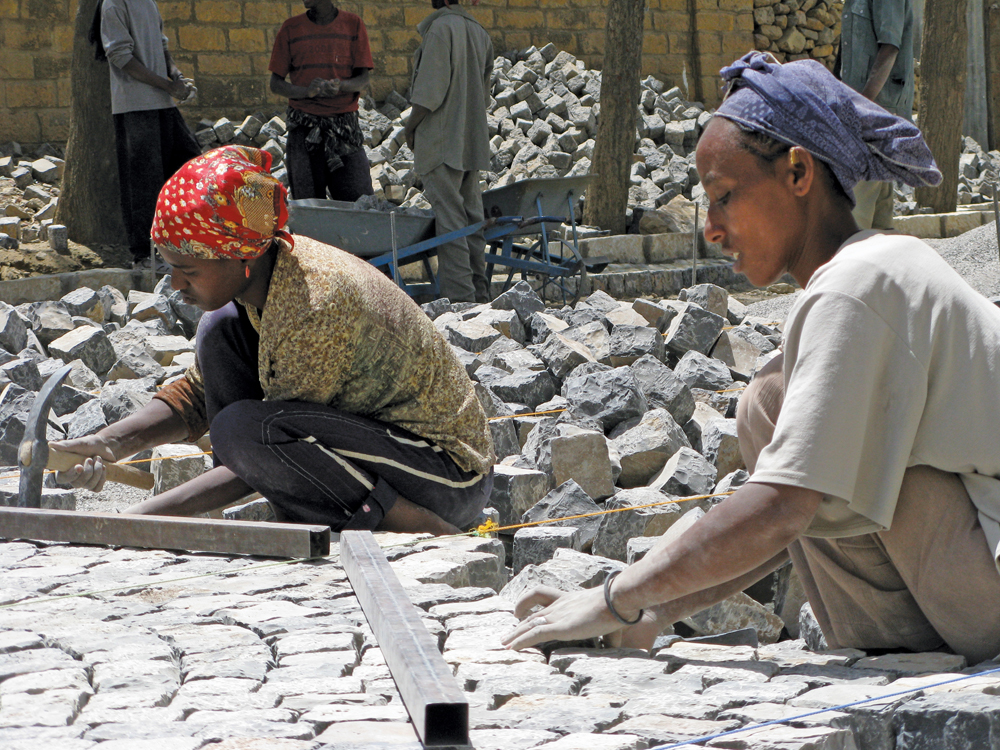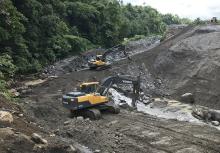
The nascent cobblestone construction industry in Ethiopia is proving to be a major boost in the country’s efforts to create additional employment opportunities and produce alternative road construction material.
It has also raised concerns over the lack of a regulatory framework to govern the management of quarries across the country.
However, change in this budding sector is in the air after the administration in Ethiopia’s capital, Addis Ababa, announced plans to carry out an environmental and social assessment study for the quarries in the city’s environs, even as experts call for sound management of the mines to ensure cobblestone mining is sustainable and continues to generate road construction material and job opportunities.
Although road construction with cobblestones is limited to inter-city roads, walkways, car parks and inter-community links, the reduced construction costs and involvement of communities has brought to the fore the increasing importance of cobblestone quarries in Ethiopia and concerns over the haphazard manner many of these mines are operated.
Experts now say the quarries are posing a safety risk because they have been neglected and there is no legislation to govern their opening, mining, rehabilitation and closure.
“Like that of sand and coarse aggregate mining areas, cobblestone quarries are neglected and are not rehabilitated,” says Professor Abebe Dinku, the chair at the Construction Materials and Management Department in the School of Civil and Environmental Engineering at the Addis Ababa University’s Institute of Technology.
“A recent study made in quarry sites around Addis Ababa indicated that every year many young boys lose their lives in quarry sites when filled with rainy water.”
He says the cobblestone quarry sites should be environmentally compliant by having them registered and documented by the respective city administration to enable planning for their future development.
“After the quarrying operation is done, it should be rehabilitated, complying with standard rules and regulation. It should not be left open exposing the public to unsafe conditions,” says Professor Dinku.
In early June, 2013, the Addis Ababa City administration announced plans for an assessment on the cobblestone quarries more than four years after the study was first proposed.
The study, to be done by Environmental and Development Consultants, will evaluate air pollution, land degradation, resource utilisation, social displacement and economic benefits from the quarries says Adualem Tena, the project coordinator at the Urban and Local Government Development Project office in the city’s administration.
“The assessment study was supposed to have been conducted before the implementation of the cobblestone project in 2010 and at its completion,” says Tena (talking about a cobblestone development project supported by Germany). The project entails training and financing of micro and small entrepreneurs involved in the cobblestone industry.
But experts have insisted on not only regulation of the quarries but also on proper management and utilisation of the mined stones.
According to Professor Dinku: “Proper utilisation of cobblestone size and waste minimisation are important.
“For instance, the thickness of individual stones can be reduced, while the left-over pieces can be used to produce crushed aggregate.”
He said there is need for enforceable guidelines on environmental protection during quarrying, safety at the quarries, reuse of material, and impact of the location/proximity of the quarries to the cities, and also sound and air pollution.
Despite the environmental concerns, the role of cobblestone in road construction in Ethiopia is gaining in popularity.
Cobblestone road construction projects, despite attracting smaller contractors, are now considered a more convenient and affordable alternative in paving cities in this Eastern Africa country.
The paved surfaces are considered long lasting and have low maintenance costs. At least 340km have been paved with cobblestone in Ethiopia’s main cities.
Kai Hofmann, head of Urban Poverty Section at GIZ Ethiopia claims that compared to asphalt roads, which are expensive with life spans of 10-15 years, cobblestone road projects “if well-constructed have a lifespan of many decades, have little maintenance costs and can easily be opened in case utility lines require maintenance and can be built using small contracts.”
He says: “Cobblestone road construction uses locally available material; is partly permeable; is low-skill and labour-intensive; benefits especially the urban poor and the design and construction process is low-complex, which means that cities and the local construction sector can handle it by themselves.”
“All these advantages together provide a positive impact on the local economy, since money circulates in the cities and stimulates local consumption and investments.”
Professor Dinku is now calling for participation of the private sector in the cobblestone construction projects to ensure the industry is sustainable.
For example, he says almost all cobblestone roads are mainly financed by government with little participation of the private sector.
“This poses a serious issue of sustainability when the government stops funding cobblestone construction. Cobblestones could be used by private individuals for parking spaces, compound walkways and garden areas,” says Professor Dinku.
“I see cobblestone roads as an alternative way of road construction, but not as the only solution for urban and rural Ethiopia.”
He calls for more research into how cobblestone construction can be turned into a sustainable alternative to improve Ethiopia’s road network and other surfaces.
“There is a strong potential to diversify the design and construction of cobblestone road construction and I would suggest the contribution of technical institutions in providing support in the form of design and offering technical training,” he says.
A cobblestone construction project, supported by Germany in Addis Ababa, has been such a success that it has triggered a construction frenzy of urban pavements with the material whose available amounts in Ethiopia are yet to be confirmed.
Hoffman says the cobblestone quarries have transformed the lives of the average urban and rural Ethiopians through creation of jobs especially in chiselling of stone which attracts mostly low-skilled unemployed youth, the key target group of the project.
“Other marginalised groups of the urban society such as the elderly, handicapped, people living with HIV and single-mothers do the chiselling,” he says.
With the support from Germany and local governments, Hoffman says: “The urban poor have started to organise themselves in associations to advocate for better unit prices; start saving and credit associations and to organise social support programmes.”
In addition, GIZ is supporting the micro and small enterprises (MSEs) involved in the mining, chiselling and paving of cobblestone to grow into fully-fledged contractors.
“A study in 2009 revealed almost 2,000 MSEs in nine cities had been founded, of which many are now successful contractors creating effects in the transport such as the procuring of three-wheeled taxis by MSEs with money saved from cobblestone road construction,” says Hoffman
“Ethiopia’s capital has started to invest in paving roads and other cities have significantly increased their investments in the sector. Current estimations suggest that over 230,000 jobs have been created through the sector.”
Professor Dinku concurs: “There is no doubt cobblestone construction has created significant job opportunities in the labour market with many young people organising themselves, with the guidance of the government, to form MSEs in major Ethiopian cities.”.









